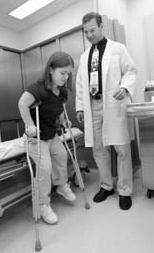Released by Associated
Press in August 2001 and published in many papers across the nation.
Dwarfs Divided Over Limb Lengthening Health:
Critics say surgery implies there's something wrong with being 'a little
person.' But those who undergo it praise life changes. .
By PAUL PAYNE, ASSOCIATED PRESS
BALTIMORE -- Wrench in hand, the orthopedic surgeon reaches into the spidery
metal contraption, searching for an adjustable screw. He maneuvers into
the miniature scaffolding, past steel rods and graphite braces, making
a few careful turns.
Dr. Dror Paley studies the objects of his handiwork--a 15-year-old girl's legs. He's extending them nearly a foot. "You're making really good bone," he tells Brittany Krupa.
The Pittsburgh-area teenager is planning to be a bridesmaid at her cousin's wedding. "You'll definitely be able to walk down the aisle." Paley is performing a radical procedure that makes dwarfs taller. He and Dr. John Herzenberg, a colleague at Sinai Hospital in Baltimore, extend the arms and legs of dwarfs by breaking their bones and slowly pulling them apart.
Patients beginning the procedure in the first grade can add 15 inches to their maximum adult height--from about 4 feet on average to 5-foot-3.
"You really change the quality of their lives, social interactions and career possibilities," Paley said.
Limb lengthening is meant to help people born with dwarfism. The most common form is achondroplasia, a genetic condition afflicting one in 10,000 newborns.
People with achondroplasia have average-sized heads and torsos but abnormally short arms and legs.
The operation isn't just about the physical, though. Those who make the hard choice to undergo the procedure say dwarfs can face a life of limitations and abuse--from finger-pointing by children to humiliating pranks such as so-called "dwarf tossing." They consider surgery a way to change how others see them, to cast off self-doubt and to join the mainstream in the quest for jobs, mates and money.
But decisions by some dwarfs to alter their bodies puts them at odds with others and with the largest organization representing those with achondroplasia. The 7,400-member Little People of America says the risk of nerve and vascular damage in the years after the surgery is great. Besides, they say, a short stature makes them unique, and limb lengthening implies there's something wrong with being "a little person."
"Do you just go along with the crowd or teach people difference is OK?" said LPA activist Colleen Gioffreda. She, her husband, Jim, and their 2-year-old son, Connor, all were born with achondroplasia. "It scares me to think people want to become more and more the same," she said.
Michael Ain, an orthopedic surgeon at Johns Hopkins Hospital, says premature arthritis is just one possible complication. "There's an enormous amount of risk," said Ain, himself a dwarf who decided against the surgery. "Nobody really knows what's going to happen to them."
Paley's patients believe they know. One of them is Gillian Mueller, 26, of Columbia, Md., who has been living with longer limbs for 13 years.
"It's one of the best decisions I've ever made," Mueller said.
At Sinai Hospital, Paley and Herzenberg run the International Center for Limb Lengthening, treating mostly birth defects and uneven limbs. But the center is one of the few facilities working with dwarfs. Others are in Lecco, Italy; Sheffield, England; Barcelona, Spain; Kurgan, Russia; and Los Angeles.
Surgeons use a technique developed about 50 years ago by Russian doctor Gavril Abramovich Illizarov. The procedure starts on the lower leg. Using a chisel, Paley and Herzenberg cut the bone in two. They insert metal rods into the halves and connect them to a brace resembling an Erector set. The brace is adjusted to pull the bone apart at a rate of about a millimeter a day.
"The bone makes new bone to fill the gap and we pull it a little more," Paley said. The bone then is set in a normal cast. The whole job takes about three years. The cost is about $150,000, including physical therapy. The procedure is covered by insurance, Paley said.
Over several months, the tibia and femur can be extended at least a foot, Paley said. The younger the patient, the better the results. Pain is managed with a combination of medicine and therapy. Patients are told beforehand of risks. About 1 in 10 lose some movement in their ankles because of muscle tightening, Paley said. But in 5,000 patients over about 15 years, there have been few serious problems, he said.
Wiggling her toes, Meredith Jones waits in Paley's office. It's been more than six months since the 19-year-old woman underwent leg surgery and she's eager to get the casts off and glimpse life from a height she's only dreamed about.
Despite an "ideal childhood" in a household with average-height parents and 6-foot-tall brothers, she began to worry about a life of barriers for someone with her 4-foot-2 stature. As she grew older, she yearned for independence.
"Being able to reach that little bar that divides your food in the grocery store checkout line would be a wonderful thing," she said.
Then she heard about Paley's clinic. Her family opposed the operation at first. "They didn't want me to change."
But after a visit to the Maryland clinic and testimonials from other patients, Jones was convinced. The only hitch was her age. Most patients begin in early adolescence when bones are more pliable and capable of yielding more length. But Paley has applied the technique in people over 60.
Jones underwent lengthening of the tibia, the lower leg bone, last August and will have surgery on her upper arms early next year. Then she'll finish with her thigh bones, "the most difficult but rewarding operation of all," she said. By then, Jones figures, she'll be about 23 and stand about 5 feet tall.
Now, with the buzz of a plaster saw, she is staring down old obstacles. Jones is all smiles as she plops in a plastic chair. "I always wondered what it feels like to sit on a chair and tap your feet," said Jones, now 4 inches taller. "I'm so proud of myself."
James and Colleen Gioffreda are proud, too, though they have not had the surgery and don't want it. They're proud of their short stature, their uniqueness, they say.
In his kitchen in Timonium, Md., James stands on a footstool, cooking pork and beans. Colleen reaches out with the grabber, a wooden stick with a claw on the end used for snatching things from shelves. Their baby son, Connor, sits in a highchair waiting for lunch. "It's not that horrible at all," said James, who met his wife at a convention for little people about four years ago.
"The biggest obstacle for me is walking into Chuck E. Cheese with my son," he said. "All the kids stop and stare the minute we enter the room."
The Gioffredas say limb lengthening is akin to cosmetic plastic surgery. Colleen hopes her son will not undergo the procedure when he's older. "That would be weird," she said.
Lunchtime chatter dies when Christy Ruhe enters Fisherman's Wharf restaurant. The 22-year-old has blond hair and a nice smile, but her legs get the most attention. And her arms. They're short.
The Columbus, Ohio, native is just 4-foot-3. She follows a waiter to her seat, head just above tabletop level. Eyes are on her when the waiter pulls a chair and she hops up in it, her pink pedicure high off the ground. Ruhe scans the room. Eyes dart back to plates.
"It bugs me," she says, "but you can't let that control you." True to her word, she has driven a specially equipped car since her 16th birthday, holds a temporary job and graduated from the University of Dayton this spring.
But obstacles--including job discrimination--are overwhelming. Things that average-height people take for granted, such as the ability to buy clothes that fit or shop without help, are out of reach. She will have surgery in October to lengthen her arms and legs.
Sitting on a sofa between her parents, Rita and John, who are average height, Christy tells of her initial skepticism. But in college she realized she wanted a life more like that of her sorority sisters, who were taller, getting jobs in exciting cities and meeting men. The decision was cemented when her older sister, Erin, who is average height, announced her engagement.
"Christy's had very few dates," said Rita Ruhe. "That's something I hope will change. Maybe someone will finally see her for who she is."
Twenty-six-year-old Gillian Mueller is Paley's poster child for limb lengthening. The athletic, 5-foot, 2-inch Columbia, Md., woman underwent her first treatment at 13, when she was less than 4 feet tall. By high school, she made the varsity soccer team.
Mueller was encouraged by her average-height parents to seek treatment. Within the first six weeks of the procedure, her lower legs were 4 inches longer. At age 15, her upper arms were operated on, and a year later, her femurs were done.
Mueller has defended herself from critics who say that she was forced to undergo limb lengthening by tall parents and that she's turned her back on other dwarfs.
"As I have said on many occasions, I did not do this to blend in with society," she wrote the LPA. "I could care less what society as a whole thinks of me.
"It is a personal decision that every individual should be allowed to make . . . without being judged by anyone for that decision."
Meredith with Dr. Paley
First Steps
Gillian and Meri


